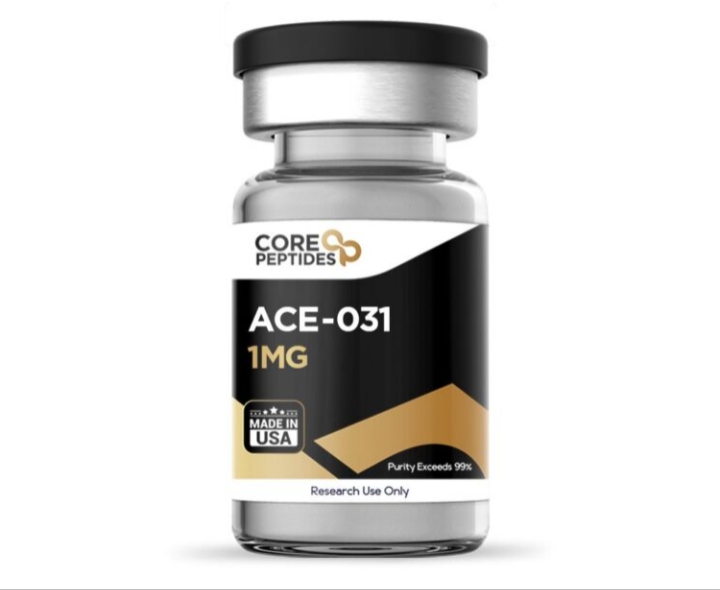ACE-031 peptide has been researched extensively, seemingly yielding promising results in studies associated with muscle protection. Some of those studies will be discussed in more depth down below.
Throughout an organism’s lifetime, it undergoes the processes of muscle formation, growth, and regeneration. These essential bodily processes start at the embryonic stage and continue through the fetal and adult stages.
Myostatin, first identified as an endogenously generated protein by myocyte cells in 1997 [I], may suppress muscle cell proliferation. Muscle development was increased by 50% in animals lacking these proteins [i]. The ability to counteract or block the process through which Myostatin inhibits muscle development was essential.
Research suggests the peptide ACE-031 may be useful in this context. Animal studies have speculated that the peptide may aid test subjects with stunted muscle development, as this peptide appears to interfere with the Myostatin protein’s normal function.
What is ACE-031 Peptide?
According to research, ACE-031 is the fusion product of the type IIB activin receptor and recombinant immunoglobulin IgG1 FC, and an antibody [ii], also known as ACVR2B (activin receptor type IIB peptide).
ACE-031 Peptide Mechanism Of Action
Researchers suggest that muscle development may be controlled by proteins that act like “on” and “off” switches in the body. According to studies, this peptide may be effective because it has the potential to block the ‘off’ signal from being sent throughout the body, thereby turning off the switch.
Myostatin is a protein, and, as findings have suggested, the ACE-031 peptide may bind to it to block its functions. As a result, the ‘off’ signal could be suppressed, and muscle development encouraged. Licensed professionals speculate that the peptide has the potential to aid in muscle mass development and the enhancement of muscular strength.
ACE-031 Peptide Research Studies
Research in Muscle
The peptide’s potential effectiveness in muscle protection was tested in a randomized, double-blind, placebo-controlled clinical experiment [iii], including healthy post-menopausal female test subjects.
According to this research, the peptide-treated subjects increased their total body muscle mass by 3.3% and their thigh muscle mass by 5.1%. Extra bioanalysis also indicated that the substance had the potential to boost the subjects’ fat and bone metabolism.
Research On Optimal Muscle Cells
Research speculated that the protein Myostatin was shown to be a negative regulator of skeletal muscle development, as predicted by the literature [iv]. The activin receptor type IIB on skeletal muscles is where the signal from these proteins, which leads to muscle wasting, is largely sent in the body.
Studies suggest that this peptide, a soluble activin receptor type IIB, may prevent muscle wasting and provide optimal muscle protection because it allegedly operates by interacting with Myostatin and counteracting its effects.
Research in Vitality and Metabolism
Myostatin may potentially inhibit muscle development and significantly impact skeletal muscle energy consumption, as implied by recent studies [v] conducted on mice. Excess Myostatin, simply put, may cause greater weariness and lethargy.
Mice studies [v] suggest that preventing the production of ACE-031 proteins may lead to elevated blood lactate levels and severely deplete skeletal muscle metabolic energy. Therefore, the peptide may potentially reduce myostatin-induced muscle development suppression and enhance oxidative muscle capability. Increased energy metabolism in skeletal muscles is believed to protect them against overexertion and the harmful consequences of radical generation.
Research in Muscle Strength
Scientists have been studying this peptide for some time [vi], and their findings have speculated that it may have a purpose other than blocking Myostatin. Researchers imply that this peptide may potentially reduce oxidative stress on muscle tissue, which in turn may help the muscle save energy and encourage oxidative respiration.
Mice given the substance showed a 40% increase in maximum contractile force and a 25% increase in total contractile force. Clinical trials of the ACE-031 peptide have not yet been done; however, this work suggests it may increase muscular strength.
Research in Bone Mass
Thirty-two mice were used in the study, each randomly assigned to receive either a placebo or the peptide once a week for seven weeks [vii].
At the end of the trial, the mice given ACE-031 peptide had a higher bone density, muscle mass, and body weight than the control group. The higher bone density in the peptide-treated mice was reported to be causal, with the improved mineralization leading to a 30% improvement in bone strength.
If you are a researcher interested in purchasing ACE-031 peptide for your clinical studies, you can do so if you click here. Please note that none of the items listed are approved for human or animal consumption. Laboratory research chemicals are only for in-vitro and in-lab use. Any kind of physical introduction is illegal. Only authorized academics and working professionals may make purchases. The content of this article is intended only for instructional purposes.
References
[i] McPherron AC, Lawler AM, Lee SJ. Regulation of skeletal muscle mass in mice by a new TGF-beta superfamily member. Nature. 1997 May 1;387(6628):83-90. https://pubmed.ncbi.nlm.nih.gov/9139826/
[ii] Campbell C, McMillan HJ, Mah JK, Tarnopolsky M, Selby K, McClure T, Wilson DM, Sherman ML, Escolar D, Attie KM. Myostatin inhibitor ACE-031 treatment of ambulatory boys with Duchenne muscular dystrophy: Results of a randomized, placebo-controlled clinical trial. Muscle Nerve. 2017 Apr;55(4):458-464. https://pubmed.ncbi.nlm.nih.gov/27462804/
[iii] Attie KM, Borgstein NG, Yang Y, Condon CH, Wilson DM, Pearsall AE, Kumar R, Willins DA, Seehra JS, Sherman ML. A single ascending-dose study of muscle regulator ACE-031 in healthy volunteers. Muscle Nerve. 2013 Mar;47(3):416-23. https://pubmed.ncbi.nlm.nih.gov/23169607/
[iv] Morvan F, Rondeau JM, Zou C, Minetti G, Scheufler C, Scharenberg M, Jacobi C, Brebbia P, Ritter V, Toussaint G, Koelbing C, Leber X, Schilb A, Witte F, Lehmann S, Koch E, Geisse S, Glass DJ, Lach-Trifilieff E. Blockade of activin type II receptors with a dual anti-ActRIIA/IIB antibody is critical to promote maximal skeletal muscle hypertrophy. Proc Natl Acad Sci U S A. 2017 Nov 21;114(47):12448-12453. https://pubmed.ncbi.nlm.nih.gov/29109273/
[v] Relizani K, Mouisel E, Giannesini B, Hourdé C, Patel K, Morales Gonzalez S, Jülich K, Vignaud A, Piétri-Rouxel F, Fortin D, Garcia L, Blot S, Ritvos O, Bendahan D, Ferry A, Ventura-Clapier R, Schuelke M, Amthor H. Blockade of ActRIIB signaling triggers muscle fatigability and metabolic myopathy. Mol Ther. 2014 Aug;22(8):1423-1433. https://pubmed.ncbi.nlm.nih.gov/24861054/
[vi] Béchir N, Pecchi E, Vilmen C, Le Fur Y, Amthor H, Bernard M, Bendahan D, Giannesini B. ActRIIB blockade increases force-generating capacity and preserves energy supply in exercising mdx mouse muscle in vivo. FASEB J. 2016 Oct;30(10):3551-3562. https://pubmed.ncbi.nlm.nih.gov/27416839/
[vii] Puolakkainen, Tero et al. “Treatment with soluble activin type IIB-receptor improves bone mass and strength in a mouse model of Duchenne muscular dystrophy.” BMC musculoskeletal disorders vol. 18,1 20. 19 Jan. 2017. https://www.ncbi.nlm.nih.gov/pmc/articles/PMC5244551/
Collins Nwokolo is a human physiologist, writer and health enthusiast. He loves writing helpful articles on health and fitness, which he enjoys sharing with everyone.










